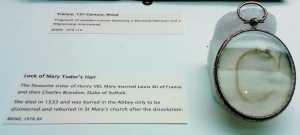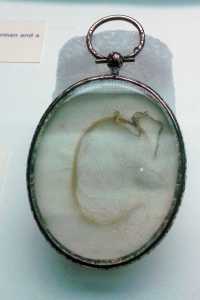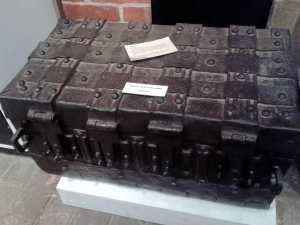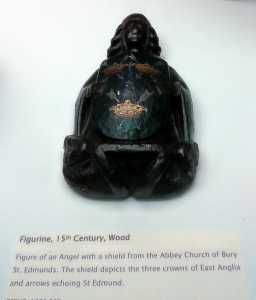The Mid-Anglia branch of the Richard III Society descended on Bury St Edmunds on Saturday the 12th September. We were lucky enough to have another brilliantly sunny day with no sign of rain and met up in Starbuck’s just across from our first and main objective, the Moyse’s Hall Museum.
This museum is housed in an ancient building dating from the time of the Town’s namesake, Edmund, who was king of England in the ninth century. Our knowledgeable guide, Alex, enthralled us with his tales of years gone by, beginning with Edmund himself. The ‘Bury’ in the town’s name has nothing to do with burying Edmund, but rather is another form of ‘burgh’, meaning ‘town’. The town began as a shrine to St Edmund, who in 869/70 was captured and killed by the Danish Vikings who were in the habit of invading England at that time. They tied him to a tree and shot him with arrows before beheading him. When his men arrived they found his body, but no sign of his head. As they were about to give up the search, they heard a voice calling: “Hic! Hic!” the Latin for “Here! Here!” and, following it, they found a wolf keeping guard on Edmund’s lost head. He was made a saint and his resting place became a shrine. Thus, also, began the wolf legend and it is still referred to today since, for the weekend, they had laid a ‘Wolf Trail’ around the town for visitors to follow. There is a skull of a wolf or dog found in the area, which is one of many found there and this adds to the legend.

St Edmund’s shrine grew into an abbey, and the town grew up around it since the abbey provided employment, spiritual aid, etc. The abbey owned a lot of land thereabouts and the town was very important. This was probably partly because St Edmund was then England’s patron saint. In fact it was so important that, on a mediaeval European map of the known world the only two places shown in England were London and Bury St Edmunds.
Some of the architecture in the building itself even dates back that far and there are other sections of the building which have architecture from differing periods, providing a great tour through the ages.
One of the highlights of the tour was the ‘Crime’ section featuring a gibbet, a metal human-shaped cage in which criminals were displayed as a deterrent to others. However, apparently, the punishment wasn’t that you were placed in there until you died of thirst because it was after you were executed (usually by hanging), that your body would be displayed there. The extra punishment was the knowledge that your body would be dissected afterwards by surgeons or your bones scattered. This meant that you would be unable to go to heaven. Moyse’s Hall Museum is unique in that it possesses a photo of the skeleton (still in the gibbet) of a man executed for murdering his sister – the said photo is displayed beside the very same gibbet!
Further on there is an exhibit of various objects associated with witchcraft, such as mummified cats (probably locked up alive within a wall to so its spirit would guard the house), shoes (used the same way), ‘voodoo’ type dolls and various other witchy paraphernalia.
Next came the notorious Red Barn murder. William Corder was accused of murdering his lover, Maria Marten, having been found out because her stepmother had a dream which showed where Maria was buried – in the Red Barn. The defendant said she had committed suicide, but the jury didn’t believe him and he was hanged. He was so hated that he was taken to his execution by an inside route to avoid the baying crowds. But the story didn’t end there; several death masks were made afterwards, one on display in the museum, as well as a death mask used for the study of his skull by phrenologists. His skin was tanned and used to bind a book (an account of the murder), which is one of the exhibits. Our guide Alex, did not believe that all was as it seemed and felt Corder had been harshly judged.
There was an exhibit on trade, and following on from that was the most interesting for a Ricardian, a lock of hair belonging to Mary Tudor, daughter of Henry VII and Elizabeth of York and sister to Henry VIII.


She was the niece of the ‘princes’ and therefore Richard’s great niece. There were also some 15th century wood carvings and a beautiful old fifteenth century deed chest.



Up the stairs, which was devoted to one of the largest collections of Mary Beale paintings, would be found a room dedicated to the Suffolk Regiment through the years, with life-size, realistic mannequins of soldiers in different style uniforms, depending on the time and whether it was preferable to stand out from the crowd or blend in. They wore red when they wanted to stand out and be recognised by their own fellow soldiers, but when the sniper became common that was understandably changed and camouflage became the norm..
There was an exhibit of clothing and more paintings, and finally a room full of clocks and watches. Some of these were very intricate and exquisitely beautiful, and many were very rare examples. Alex told us that there had been a theft of some of them from the place where they were previously kept and that they would have no doubt been stolen to order by a collector as all the dealers would have recognised them for what they were.
It is a huge place and has many interesting exhibits from the time of Edmund himself right up until the present day; over 1000 years of history. We were there for one and half hours and the time flew by as our guide, Alex, was so interesting.
All in all a thoroughly good time was had and we learned a lot.


I think Bury St. Edmunds is underrated – I always enjoyed visiting, esp the Abbey grounds
LikeLiked by 1 person
Hello! My name is Sarah Bryson and I am currently writing a book on Mary Tudor, Dowager Queen of France. I apologise for leaving a message here but I was unable to find your e-mail! I was wondering if it were all possible if you could e-mail me at SBryson44@Hotmail.com I would love to ask you some questions about your visit to Bury St Edmunds. (I’m from Australia and can’t visit myself!)
Thank you.
LikeLiked by 1 person
We haven’t set up an e-mail address yet and probably should have done – it would be a pleasure to discuss this further when we have.
LikeLike
Thank you so much!
LikeLike